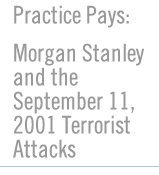Some disasters will require employees to leave the workplace quickly. The ability to evacuate workers, customers and visitors effectively can save lives. People who plan and practice how they will get out of the building in an emergency are better prepared than those who do not have an exit strategy.
- If feasible, develop a system for knowing who is in your building, including customers and visitors, in case there is an emergency.
- Decide in advance who has the authority to order an evacuation. Create a chain of command so that others are authorized to act in case your designated person is not available. If local officials tell you to evacuate, do so immediately.
- Identify who will shut down critical operations and lock the doors, if possible, during an evacuation.
- Choose employees most able to make decisions that emphasize personal safety first.
- Train others who can serve as a back-up if the designated person is unavailable.
- Write down, distribute and practice evacuation procedures.
- Locate and make copies of building and site maps with critical utility and emergency routes clearly marked.
- Identify and clearly mark entry-exit points both on the maps and throughout the building.
- Post maps for quick reference by employees.
- Keep copies of building and site maps with your crisis management plan and other important documents in your emergency supply kit and also at an off-site location.
- Make copies available to first responders or other emergency personnel.
- Plan two ways out of the building from different locations throughout your facility.
- Consider the feasibility of installing emergency lighting or plan to use flashlights in case the power goes out.
- Establish a warning system.
- Test systems frequently.
- Plan to communicate with people who are hearing-impaired or have other disabilities and those who do not speak English.
- Designate an assembly site.
- Pick one location near your facility and another in the general area in case you have to move farther away.
- Talk to your people in advance about the importance of letting someone know if you cannot get to the assembly site or if you must leave it.
- Be sure the assembly site is away from traffic lanes and is safe for pedestrians.
- Try to account for all workers, visitors and customers as people arrive at the assembly site.
- Take a head count.
- Use a prepared roster or checklist.
- Ask everyone to let others know if they are leaving the assembly site.
- Determine who is responsible for providing an all-clear or return-to-work notification. Plan to cooperate with local authorities responding in an emergency.
- Conduct employee training, exercises and drills including procedures for evacuating high-rise buildings on a regular basis.
- Plan for people with disabilities who may need help getting out in an emergency.
- If your business operates out of more than one location or has more than one place where people work, establish evacuation procedures for each individual building.
- If your company is in a high-rise building, an industrial park, or even a small strip mall, it is important to coordinate and practice with other tenants or businesses to avoid confusion and potential gridlock.
- If you rent, lease or share space with other businesses make sure the building owner and other companies are committed to coordinating and practicing evacuation procedures together.
- Make a Shelter-In-Place Plan.







